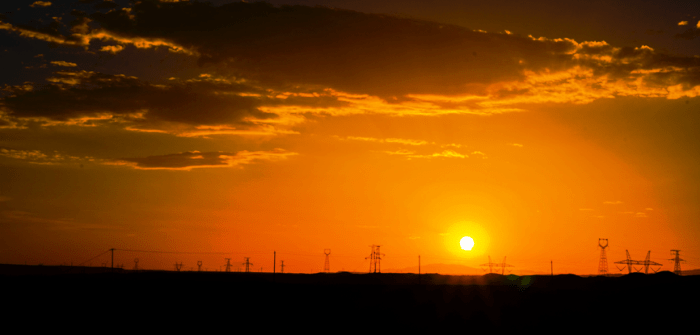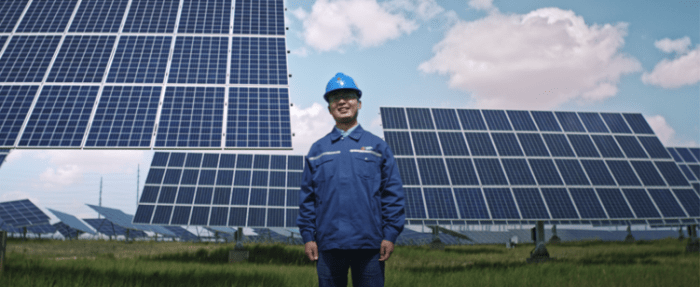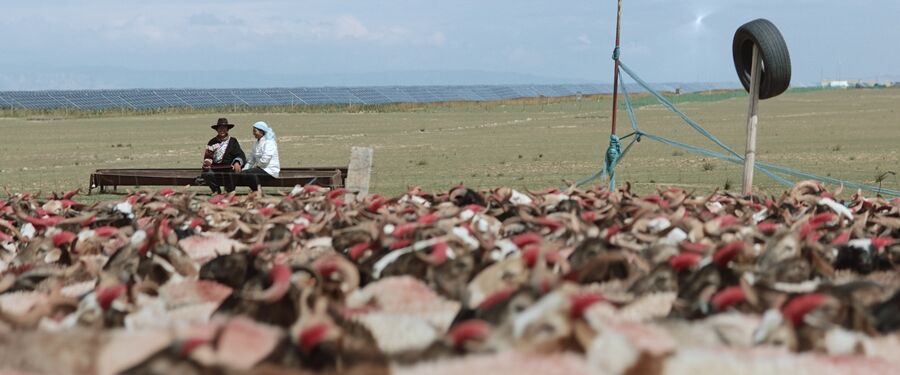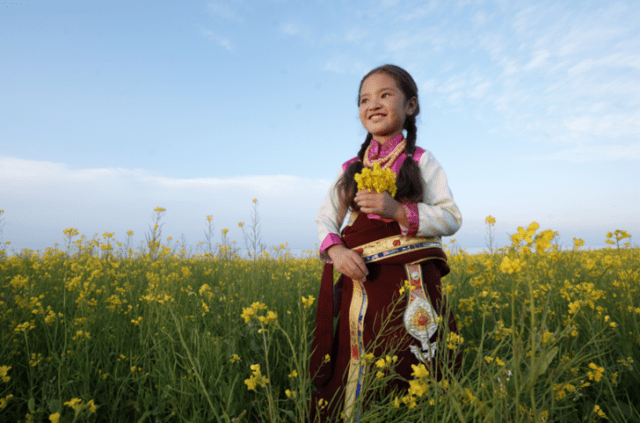In Chinese, Qinghai means blue waters. Named after Qinghai Lake, China's largest inland salt lake, Qinghai
Province
attracted worldwide attention in November 2020 when two 10 million-kW renewable energy bases were completed
in the
Hainan and Haixi prefectures. We took a trip to the PV power station in Talatan, Gonghe County, 60 km
southeast of
the lake.
As you travel from the provincial capital Xining to Gonghe County, the steep mountains on both sides of the
road
gradually recede and the horizon gradually widens. The azure sky, fluffy clouds, verdant hills, and herds of
wandering cattle and sheep evoke serenity and peace. The white caps of snow on distant mountains are the
only trace
of the previous night’s wind and snowfall.
Intelligence and low carbon are two key trends moving forward
Prior to 2011, the remote and sparsely populated Gonghe County was relatively unknown. When construction
began on
the world's largest renewable energy base, a monumental undertaking given how difficult it was to bring in
cranes
and equipment, the county bustled into its busiest time ever. The decade also saw the rapid development of
auxiliary
industries like catering, accommodation, auto repairs, ironware, and construction materials.
This level of activity had only been approached once before – in the 1980s, when the Longyangxia Hydropower
Station
was built.
September 26, 2020 was a memorable day for both Huawei and energy specialists Huanghe. At 17:18, the last
segment of
the Qinghai Gonghe 2.2 GW PV power station was connected to the power grid, marking the rollout of a power
source
that would support the world's first UHVDC power transmission project to transmit 100% clean power. Gonghe
PV power
station isn’t just the world's largest PV power station – it also boasts the shortest completion time of any
new
energy power plant, taking just one year from bidding to connecting to the grid.
The Qingyu UHVDC power transmission line that the plant supports stretches 1,563 km from Hainan in Qinghai
Province
to Zhumadian in Henan Province and is capable of lighting up the Central Plains region with 100% clean
power.
Both the power station in Gonghe and the province’s wind power plants connect to the power grid, providing
capacities of 15.436 million kW in Hainan and 10.12 million kW in Haixi. Each of the renewable energy bases
now has
a capacity of 10 million-kW.

Qing Yu UHV DC spans up to 1563 km, enabling sunlight from the northwest plateau to light up households
in the
central plains.
Ten years ago, China's inverter market was dominated by central inverters.In 2013, Huawei and Huanghe
deployed
string inverters in the Golmud PV power station in Qinghai, marking the first time string inverters were
installed
in a large- scale, ground- mounted PV plant.This broke the dominance of central inverters and spurred new
development in the PV industry.In 2014, the two companies launched the smart PV solution based on string
inverters
to digitalize PV power stations.One year later, Huawei established the Smart PV Joint Innovation Center with
Huanghe, which soon developed Smart I- V Curve Diagnosis technology, revolutionizing O& M and slashing
LCOE(Levelized Cost of Energy).
In 2017, string inverters overtook central inverters to become the mainstream PV inverters. Smart I-V Curve
Diagnosis is widely used worldwide today, replacing complex and inefficient manual O&M and inspections and
accelerating the arrival of affordable PV. A little spark starts a great fire – Smart PV began by the Yellow
River
and now the 609- square-kilometer Gonghe PV power station is one of the world's largest PV power stations,
complemented by the 100 MW Demonstration Power Station.

The cumulative fault rate of Huawei smart PV service in Talatan, Gonghe is less than 0.6‰.
According to Xie Xiaoping, Chairman of Huanghe, the two companies achieved outstanding results due to
aligned
resources and complementary strengths. A timespan of just ten years saw the development of the world's first
100%
clean energy UHV power transmission line as well as the world’s largest renewable energy base, PV power
operator,
single PV power station, hydro- solar power plant, and demonstration base.

This region through which the Yellow River flows is home to six of the world's biggest clean energy
projects.

A corner of the 100 MW Demonstration Power Station
Powered by Huawei's digital information technologies, 5G networks, and smart handheld terminals, Huanghe had
built
the country's largest centralized new energy control center.With more than 20 million data measurement
points, the
center centrally manages 34 PV power stations, providing services like big data analysis, remote diagnosis,
and
real- time maintenance.
Plans are in place for a new PV park spanning 609.6 square kilometers – roughly the land area of Singapore –
and a
2,400-square-kilometer wind farm.
By the end of 2020, the renewable resources in Hainan totaled an installed capacity of 18.65 million kW,
including 9
million kW of PV power, 5.5 million kW of hydropower, 4.1 million kW of wind power, and 50,000 kW of
solar-thermal
power.
Folk songs make a return in Talatan
Located in the upper reaches of the Yellow River, Talatan was once a landscape of windswept sand, plagued by
drought
and overgrazing.
Since 2011, PV power has helped gradually restore the degraded vegetation and revitalize the grassland
ecosystem,
with solar energy increasing soil moisture and reducing evaporation from the soil’s surface. Local residents
herding
sheep under seemingly endless rows of solar panels on the Qinghai-Tibet Plateau is a living example of how
technologies can coexist harmoniously with nature. The sky is blue, the wilderness is vast, and the wind
sings to
cows and sheep through the grass.
In just 10 years, Talatan was restored to the way it once was – its green past has time-traveled to the
present and
the sound of folk songs can be heard again.

Herding sheep under solar panels in Talatan

Sheep running towards the PV park
On our way to Talatan, Huan Xingsheng, the deputy director of production technology for Huanghe’s PV O&M
company,
believes that "solar grazing" embodies the nature of this land – and the term is currently being registered
as a
trademark.

Huan Xingsheng at the renewable energy site
Fifty-year old Duo Goujie lives in Tiegai Town, where he and his wife raise over 550 small-tailed Han sheep,
which
graze in rich fields nearby.
"Before, there was no fertile grass here. It used to grow in clumps, with sand all over it, just like the
kind you
see on the roadside. The sheep didn't like it, " says Duo with a smile.

Duogoujie and his wife at their sheepfold
When first planning for the PV project in Talatan, Huanghe sought ways to deploy PV power stations in a way
that
would benefit both the natural ecosystem and the PV industry. To absorb the impact of desert wind and sand
on solar
PV panels, Huanghe sowed pasture seeds around the PV park. The grass inside the park soon grew far higher
than the
grass outside it.
"The grass grows better because the shelter of the PV panels reduces evaporation from the soil surface, and
the
water used to clean the PV panels increases soil moisture," says Huan Xingsheng.
However, this creates new challenges: Grass that grows too tall stops sunlight reaching the PV panels and
affects
power generation. The grass also catches fire easily when it withers in winter. In 2015, Huanghe migrated
600 sheep
into the park. They kept the grass at a certain height so it power generation remained unaffected and life
was made
far easier for the farmers.
Also in 2015, Huanghe began researching the environmental impact of large-scale PV power stations. It found
that
their deployment improved soil moisture and vegetation growth, cutting average wind speeds by 41.2% and
daily air
temperatures by 0.5℃, while improving average daily air humidity by 2.1% and soil moisture by 32% at 20 cm
deep.
As a result, Huanghe adjusted the design of the PV supports from 50 cm to 1.2 m above ground. The increased
construction costs were offset by signing grazing agreements with local farmers, employing local villagers
to help
construct and maintain the PV park, and growing cash crops like snow chrysanthemums and Togou grass in the
park. The
model of jointly benefiting the ecosystem and local people by deploying solar technology has in turn boosted
the PV
industry, local transportation, construction, and tourism, leading to the development and prosperity of
minority
groups in the upper Yellow River.
In 2018 in response to the success in Talatan, the State Key Laboratory on Ecological Water Conservation in
Northwest Arid Regions set up a branch at Huanghe dedicated to researching the management of areas that,
like
Qinghia, are arid or have turned to desert.

The herdsman's daughter Duojienaocuo
Supported by the world's largest renewable energy base, Qinghai's power grid has achieved several milestones
since
2017 for providing uninterrupted green power, achieving 7, 9, 15, and then 30 consecutive days.
On August 16, 2021, it achieved a record 100 days.
Looking out from a 30-meter-high inspection tower is a blue ocean of PV panels that contrasts with Qinghai
Lake a
short distance away. Today, this land is alive with joy, with more than 5,000 sheep grazing in the park and
the
sound of singing farmers floating over the grasslands.

Qinghai Lake, renowned for its natural beauty